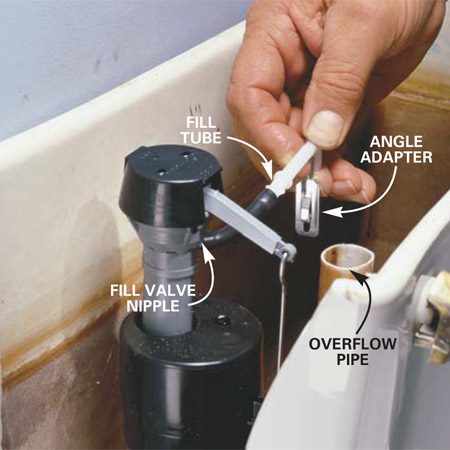An overflowing toilet tank can be a messy and frustrating problem. If you’re dealing with this issue, don’t worry – you can fix it yourself with a few simple tools and a little know-how. Here’s a comprehensive guide to help you get your toilet back in working order.

Image: masterdrain.ca
Understanding the Overflow Tube
The overflow tube is a crucial part of your toilet tank. It prevents water from overflowing the tank and causing a mess. The tube is typically located at the top of the tank, near the fill valve. When the water level in the tank rises too high, the overflow tube allows the excess water to drain out.
Troubleshooting and Solutions for an Overflowing Toilet Tank
1. Adjust the Fill Valve
The most common reason for an overflowing toilet tank is a faulty fill valve. This valve controls the flow of water into the tank. If the fill valve is not adjusted properly, it can cause the water level to rise too high. To adjust the fill valve, simply turn the adjustment screw clockwise to lower the water level or counterclockwise to raise it.
2. Clean the Overflow Tube
If the fill valve is not the problem, the next step is to check the overflow tube. The tube can become clogged with mineral deposits or other debris, which can prevent water from draining out of the tank properly. To clean the overflow tube, simply remove the cap at the top of the tube and use a small brush or pipe cleaner to clear any clogs.
3. Replace the Flapper
The flapper is a rubber seal that sits at the bottom of the toilet tank. When the toilet is flushed, the flapper lifts up to allow water to flow into the bowl. If the flapper is worn or damaged, it can leak, causing the water level in the tank to rise too high. To replace the flapper, simply unhook the old flapper from the flush valve and install the new one.
4. Replace the Fill Valve
If none of the above solutions fix the problem, you may need to replace the fill valve. To do this, you will need to turn off the water supply to the toilet and disconnect the fill valve from the water line. Once the fill valve is disconnected, you can simply unscrew it from the toilet tank and replace it with a new one.
FAQs About Overflowing Toilet Tanks
Q: Why is my toilet tank overflowing?
There are several reasons why a toilet tank might overflow, including a faulty fill valve, a clogged overflow tube, a worn or damaged flapper, or a faulty flush valve.
Q: How can I prevent my toilet tank from overflowing?
There are several things you can do to prevent your toilet tank from overflowing, such as regularly cleaning the overflow tube, replacing the flapper every few years, and adjusting the fill valve to the proper water level.
Q: I’ve tried all of the solutions in this article, but my toilet tank is still overflowing. What should I do?
If none of the solutions in this article work, you may need to call a plumber for assistance. A plumber can diagnose the problem and make the necessary repairs.

Image: dismantletoilet.blogspot.com
How To Fix Overflowing Toilet Tank
Conclusion
If you’re dealing with an overflowing toilet tank, don’t despair. By following the steps in this guide, you can easily fix the problem yourself and get your toilet back in working order. Are there any other questions you have about fixing an overflowing toilet tank?